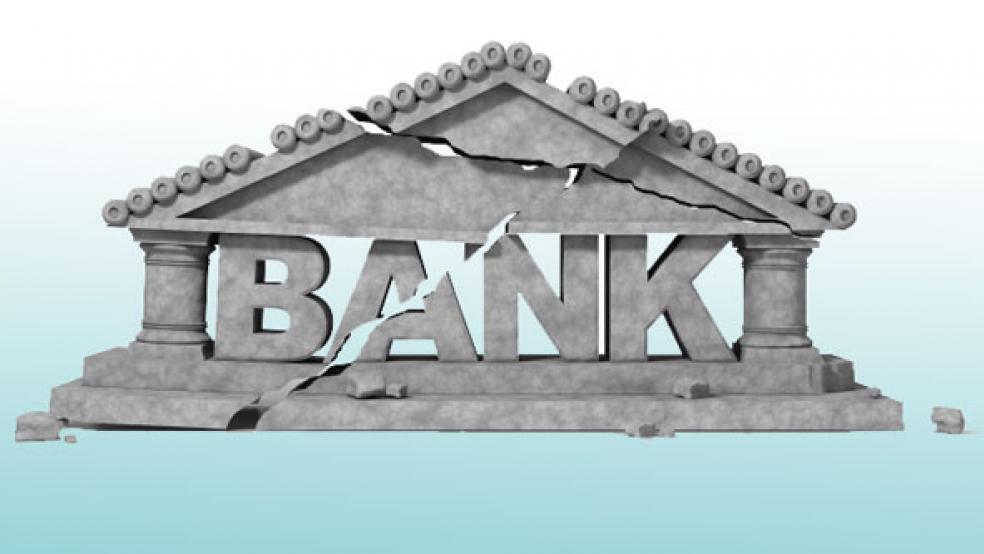Money laundering is a crime in America, but we see a version of it in newspapers every day. When corporations want to shape public opinion without directly advocating for deregulation or tax relief, they launder that opinion through a nominally “independent” third party. This is the role of think tanks, funded by corporate donations to provide “dispassionate” analysis and give an imprimatur of seriousness to what amounts to a business lobby wish list. And we had a rather depressing example of that this week.
The American Action Forum put out a thin “research paper” on Wednesday, musing that regulations in the Dodd-Frank financial reform law might cost the economy up to $895 billion over the next 10 years. “Musing” may overstate how much faith you can put in the analysis. In fact, even the author, former Congressional Budget Office head Douglas Holtz-Eakin, wants nothing to do with it.
“Clearly, such a computation is subject to large uncertainties, but the order of magnitude is instructive,” Holtz-Eakin writes, essentially admitting that the $895 billion number doesn’t necessarily correspond with reality, but has importance because it’s, well, big.
Related: The Spectacular, Too Big Failure of Dodd-Frank
Actually, the number is not that big. Using a 10-year period magnifies the raw dollar amount. U.S. annual GDP in 2014 was $17.4 trillion. An $895 billion cost over 10 years amounts to 0.059 percentage points annually, per the AAF numbers. “It doesn’t change the growth rate dramatically — it’s not even a percentage point,” Holtz-Eakin acknowledged to The Wall Street Journal.
But “Dodd-Frank costs 0.059 percentage points a year” doesn’t look good in a headline, so Holtz-Eakin spread it out to make a bigger number. He added that this costs $3,346 for every working-age American, which sounds huge until you realize that this is over a 10-year period, and the actual number is less than a dollar a day.
Keep in mind that Dodd-Frank is meant to prevent a financial crisis of the scale that reduced GDP by 5.1 percent from the end of 2007 to the beginning of 2009, which offers some perspective on why you might roll back GDP ever so slightly to restore stability and safety. But that presumes the American Action Forum number is actually correct, and Holtz-Eakin assures us it isn’t. “Everyone should take all of this with a grain of salt… I have no belief that I’ve nailed it,” he told the Journal. And on that point we agree.
The “paper,” if it can be called that, is a breezy four pages long. And most of that is taken up with devising a standard formula to measure changes in GDP, and plugging in the numbers. Holtz-Eakin advises readers that the paper contains “unreadable econo-gibberish… an alternative is to watch this short video.”
I did both. The computations in the paper hinge on “The American Action Forum’s analysis of the Federal Register,” arriving at a figure of $14.8 billion a year in compliance costs for banks to abide by Dodd-Frank regulations, adding over six percentage points to their effective tax rate. The work performed in getting to this figure is not shown, and again, Holtz-Eakin has outwardly said he has no confidence that they are correct. Compliance costs can be piled onto existing work duties, can be offset by lower legal costs for non-compliance and are subject to a host of internal and external factors.
Related: How Paul Volcker Would Overhaul Wall Street Watchdogs
Because that number wasn’t big enough, I guess, Holtz-Eakin added the increase in capital requirements as a “tax” on growth as well, even though equity capital can be used to make loans and encourage investment. Plenty of economists, like Stanford’s Anat Admati, have shown that better capitalized banks add to growth, particularly by reducing the risk of a future crisis.
The video exposes Holtz-Eakin’s debatable premise. He claims that compliance costs capture a sliver of the money designed to flow through banks, from savings deposits to businesses and entrepreneurs. One assumes Holtz-Eakin would have a much bigger problem, then, with bank profits or dividends, which also disrupt that smooth flow of capital from savers to businesses. Maybe he can compute the economic cost of bank profits next time.
Moreover, there’s an implicit assumption made that, absent these compliance costs, the money involved would automatically be circled into the real economy, for businesses to invest. Given that banks don’t do a lot of banking anymore, presumably in a deregulated world, those funds would actually be channeled to the same kinds of derivatives trading and casino gambling that we saw prior to the crisis. The productive utility of such behavior is, well, let’s call it questionable. Maybe Holtz-Eakin would reply that derivatives trading has an economic benefit, but of course, so does hiring compliance officers and paying them.
Related: Bernie Sanders Wants to Break Up the Big Banks
Regardless of the faulty premises, it’s stunning that Holtz-Eakin can totally disavow his numbers and yet still get them reported in America’s most prominent business newspaper. But that’s the exact result that funders of groups like the American Action Forum hope to achieve.
As a 501(c)(3), AAF does not disclose its donors. But we do know that several Wall Street figures — including former Wachovia CEO Robert Steel, investment banker Ken Langone, bank lobbyist Ed Gillespie and founder of Thayer Capital Partners Fred Malek — played a role in creating the think tank and its partner organization, the American Action Network.
Here’s how these things typically work. A corporate funder wants to show that Dodd-Frank is costing a lot of money. They get the American Action Forum to publish a paper proving their claims. The author of the paper is mildly embarrassed by the request, but he plows forward. And then The Wall Street Journal writes it up, uncritically headlining the dubious number, which comes from an “outside” think tank instead of the corporation itself. I don’t know this was the case with AAF, but they are free to disprove me by disclosing all their secret funders.
The public trust in news and information is therefore corrupted by front groups effectively selling their economic analysts. One would think that Holtz-Eakin, a formerly respected manager of a non-partisan budget scorekeeper, wouldn’t want to play this game, and as evidenced by his backing off the conclusions, it clearly bothers him.
As well it should. I think money laundering is an apt description for this. Instead of corporations expressing their own opinions, they funnel them through a third party to dupe the public. If we want to debate whether Dodd-Frank is too burdensome — or, as I believe, not transformative enough — that’s a worthwhile discussion. But creating a propaganda outfit to hide the messenger turns the whole exercise into public relations.
Top Reads from The Fiscal Times:
- The Liberal Solution to America’s Big Spending Problem
- How Millennials Could Damage the U.S. Economy
- Uh Oh! Congress Is ‘Fixing’ the Military Retirement System






